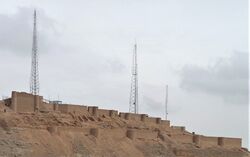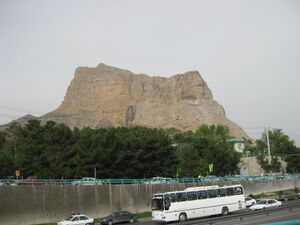شاهدز
| Shahdiz | |
|---|---|
شاهدز | |
| Near Isfahan, Iran | |
 | |
| الإحداثيات | 32°35′48″N 51°38′38″E / 32.59667°N 51.64389°E |
| النوع | Fortress |
| معلومات الموقع | |
| الحالة | In ruins |
| تاريخ الموقع | |
| قيد الاستخدام | 1107 |
| المصير | Demolished |
| المعارك/الحروب | Siege of Shahdiz |
Dizkuh (فارسية: دزکوه) or Shahdiz (شاهدز), was a fortress near Isfahan, Iran, notably held by the Nizari Ismailis. It was captured and destroyed in Seljuk sultan Muhammad Tapar's anti-Nizari campaign. Its conspicuous, picturesque ruins lie about 8 km south of Isfahan on a subpeak of Mount Soffeh.
. . . . . . . . . . . . . . . . . . . . . . . . . . . . . . . . . . . . . . . . . . . . . . . . . . . . . . . . . . . . . . . . . . . . . . . . . . . . . . . . . . . . . . . . . . . . . . . . . . . . . . . . . . . . . . . . . . . . . . . . . . . . . . . . . . . . . . . . . . . . . . . . . . . . . . . . . . . . . . . . . . . . . . . .
History
Dizkuh was a fortress in central Persia, located in the strategic route leading to Isfahan, capital of the Seljuq Empire.[1]
The historian Ibn al-Athir attributes the construction of the fortress (which he called the "Fortress (qal'a) of Isfahan") to the Seljuq sultan Malikshah, but it is more likely that it dates back earlier, even as early as the pre-Islamic Sasanian period, and the Seljuq sultan simply rebuilt the castle which was near his capital. Since then, the name Shahdiz became more common.[1]
The castle gained its fame due to the activities of the Nizari Ismailis. The Ismailis were active in the Isfahan region in the 11th century, and the chief da'i of Persia and Iraq Abd al-Malik ibn Attash had established his headquarters at Isfahan. After Hassan-i Sabbah's capture of the Alamut Castle, Abd al-Malik ibn Attash's son, Ahmad ibn Abd al-Malik ibn Attash was encouraged to seize the castle. He posed as a schoolmaster and gradually converted the garrison force of the fortress, most of whom were of Daylami origin with Shiite tendencies. By 1100, he had seized the fortress and began its re-fortification similar to the other Ismaili castles of Persia. Ahmad began to collect taxes from nearby districts.[1] He had reportedly converted 30,000 people in Isfahan. Shahdiz was strategically important as it guarded the main route to Isfahan, the Seljuq capital city. Its capture had been a major strategic success for the Nizaris.[2]
Siege of Shahdiz
| Siege of Shahdiz | |||||||||
|---|---|---|---|---|---|---|---|---|---|
| جزء من Muhammad I's campaign in the Nizari–Seljuk wars | |||||||||
| |||||||||
| المتحاربون | |||||||||
| Seljuq Empire | Nizari Ismailis | ||||||||
| القادة والزعماء | |||||||||
| Sultan Muhammad I Tapar |
Da'i Ahmad ibn Abd al-Malik ibn Attash | ||||||||
| القوى | |||||||||
| Large force |
Small force ~80 men in the final battle | ||||||||
| الضحايا والخسائر | |||||||||
| Unknown | Most of the force in the final battle | ||||||||
In 1107, soon after gaining power, Seljuq sultan Muhammad I Tapar, son of Malikshah, began a campaign against the Nizari Ismailis, focusing on Shahdiz, besieging the fortress with a large force. In an attempt to lift the siege, Ahmad tried to involve the Ismaili sympathizers in the Seljuq camp and the Sunni religious scholars (ulama) of Isfahan in a long religious debate, trying to convince them that the Ismailis are true Muslims, too, differing only in the matter of imamate; therefore, sultan's campaign is religiously illegitimate. The debate finally ended after a year and the siege continued. In another negotiation initiated by the Seljuq sultan, the Nizaris bargained for another fortress, but this negotiation was unsuccessful and ended with a fida'i attacking and wounding a particularly anti-Nizari commander (amir) of the Seljuq sultan. Later, an agreement was reached: part of the garrison to be given a safe passage to other Ismaili castles in Arrajan and Quhistan, and the remainder, around eighty men in all, who held only a wing of the fortress, was to surrender and then go to Alamut after receiving the news of the arrival of their fellow Ismailis. This news was received, but Ahmad refused to leave the fortress, apparently deciding to fight to the end. The Seljuqs attacked the fortress, and Ahmad and his small group of fighters defended themselves gallantly from tower to tower.[1][3] Most of the Ismaili fighters were killed, while a few managed to escape. Ahmad was captured, while his wife committed suicide. Ahmad and his son were executed and their heads were sent to the Abbasid Caliph Al-Mustazhir in Baghdad. The castle was demolished by the Seljuq sultan, who feared its recapture by the Ismailis. Apparently, the Khanlanjan fortress, a nearby Ismaili stronghold, was also destroyed during this campaign. The Nizari Ismailis therefore lost their influence in the Isfahan region.[1][3]
See also
References
- ^ أ ب ت ث ج Daftary, Farhad. "DEZKŪH". www.iranicaonline.org (in الإنجليزية). Encyclopaedia Iranica. Retrieved 5 October 2018.
- ^ Daftary, Dr. Farhad. "The Mediaeval Ismailis of the Iranian Lands | The Institute of Ismaili Studies". www.iis.ac.uk. Archived from the original on 3 August 2016. Retrieved 1 April 2020.
- ^ أ ب Daftary, Farhad (1992). The Isma'ilis: Their History and Doctrines (in الإنجليزية). Cambridge University Press. pp. 361–362. ISBN 9780521429740.
- Pages using gadget WikiMiniAtlas
- Short description is different from Wikidata
- Articles containing فارسية-language text
- Coordinates on Wikidata
- قلاع الدولة الإسماعيلية النزارية
- Castles in Iran
- Seljuk castles
- Buildings and structures in Isfahan province
- 12th-century fortifications
- Tourist attractions in Isfahan province
- Buildings and structures demolished in the 12th century
- Sieges involving the medieval Islamic world
- Nizari Ismaili–Seljuk conflicts
- Battles involving the Seljuk Empire
- National works of Iran
- Last stands

